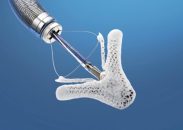Courtesy of Dr. Carlos Fava. Transcatheter aortic valve replacement (TAVR) has emerged as a successful alternative for inoperable patients and a non-inferior alternative for high- and intermediate-risk patients. While its evolution depending on site experience has been analyzed, there is currently very little information regarding the impact of operator individual experience. This study analyzed 8771 procedures performed…
More Evidence for the “Forgotten Valve.” Results from the TriValve Registry
Transcatheter tricuspid valve replacement is feasible with different devices, with a reasonable procedural success rate, and is associated with low peri-procedural mortality and significant clinical improvement. Mid-term survival was favorable in this high-risk population. Greater leaflet coaptation depth was associated with reduced procedural success, which, unsurprisingly, turned out to be an independent predictor of mortality.…
Acute Coronary Syndromes After TAVR: Frequent and Not All Undergo Coronary Angiography
Approximately 10% of patients who undergo transcatheter aortic valve replacement (TAVR) are readmitted for an acute coronary syndrome after a mean follow-up of 25 months. Male sex, prior coronary artery disease, and (surprisingly and hard to explain) nontransfemoral approach were independent predictors of acute coronary syndrome after TAVR, an event associated with high midterm mortality. While…
Continuous Monitoring of Left Atrial Pressure during MitraClip, Regardless Echocardiography
The aim of this study was to assess the use of measuring left atrial pressure to complement transesophageal echocardiography and doppler imaging. Procedure efficacy is measured in the cath lab by echocardiography. However, these measurements are operator dependent and might be influenced by left ventricular function and changes in left atrial compliance. The study…
Balloon-Expandable vs. Self-Expanding: To Each Valve Its Own Annulus
The former generation of valves, the balloon expandable (Sapien XT), was associated to less paravalvular leak than the self-expanding valves only in patients with larger annuli. The new generation of self-expanding valves (Evolut R) has managed to significantly improve sealing in patients with larger annuli and still holds potential benefits for smaller annuli. The aim…
Is TAVR at Hospitals Without Backup Cardiovascular Surgery Feasible?
Patients undergoing transcatheter aortic valve replacement (TAVR) at hospitals without cardiovascular surgery available are at significantly higher risk. That in itself is a call for attention; however, a propensity-matched analysis shows that the short- and long-term mortality rates are similar among patients treated at hospitals with and without cardiovascular surgery backup. This debate emerged a…
Aortic Stenosis and Dialysis: Is TAVR the Strategy of Choice?
Courtesy of Dr. Carlos Fava. TAVR has been shown beneficial in high and moderate risk patients, but there is a group of patients that require dialysis on account of kidney deterioration. This comorbidity is due to bad cardiovascular evolution associated to diabetes, bleeding and thromboembolic events. For some time, we have been using an…
CoreValve US Pivotal High Risk Trial: at 5 years, similar results
Courtesy of Dr. Carlos Fava. We are well aware of transcatheter aortic valve replacement’s (TAVR) effect in high-risk or inoperable patients at 5 years, even more after the PARTNER 1 trial. Yet, the outcomes of another relevant randomized study remained pending: el CoreValve US Pivotal High-Risk Trial. The CoreValve US Pivotal High-Risk Trial looked at the…
Surprises in the Physiopathology of Critical Ischemia
Luminal thrombotic occlusions associated with non-significant atherosclerosis are commonly observed in patients with critical lower limb ischemia, which suggests the possibility of thromboembolic disease as a great contributor to ischemia. This was particularly verifiable in infrapopliteal vessels, thus showing a possible mechanism of progression from peripheral vascular disease to critical ischemia, as well as a…
Differences in Stroke between TAVR and SAVR in Intermediate Risk Patients
Transcatheter aortic valve replacement (TAVR) is more and more frequent in lower risk populations that had previously been treated with surgical valve replacement (SAVR). A small difference in neurological events could have significant consequences when it comes to deciding a course of action. This study is a sub-analysis of the randomized study SURTAVI (Surgical Replacement…
TAVR in Low-Risk Patients with “Zero” Mortality and “Zero” Stroke
Transcatheter aortic valve replacement (TAVR) is now the standard of care for patients with symptomatic severe aortic stenosis who are at extreme, high, or intermediate risk for surgery. This multicenter, prospective study (Feasibility of Transcatheter Aortic Valve Replacement in Low-Risk Patients With Symptomatic, Severe Aortic Stenosis) included low-risk patients and was approved by the United…










